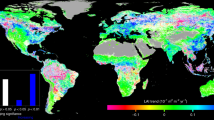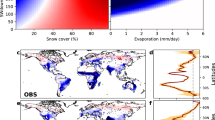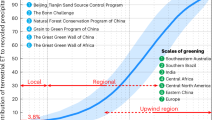Abstract
Changes in vegetation structure are expected to influence the redistribution of heat and moisture; however, how variations in the leaf area index (LAI) affect this global energy partitioning is not yet quantified. Here, we estimate that a unit change in LAI leads to 3.66 ± 0.45 and −3.26 ± 0.41 W m−2 in latent (LE) and sensible (H) fluxes, respectively, over the 1982–2016 period. Analysis of an ensemble of data-driven products shows that these sensitivities increase by about 20% over the observational period, prominently in regions with a limited water supply, probably because of an increased transpiration/evaporation ratio. Global greening has caused a decrease in the Bowen ratio (B = H/LE) of −0.010 ± 0.002 per decade, which is attributable to the increased evaporative surface. Such a direct LAI effect on energy fluxes is largely modulated by plant functional types (PFTs) and background climate conditions. Land surface models (LSMs) misrepresent this vegetation control, possibly due to underestimation of the biophysical responses to changes in the water availability and poor representation of LAI dynamics.
This is a preview of subscription content, access via your institution
Access options
Access Nature and 54 other Nature Portfolio journals
Get Nature+, our best-value online-access subscription
$29.99 / 30 days
cancel any time
Subscribe to this journal
Receive 12 print issues and online access
$209.00 per year
only $17.42 per issue
Buy this article
- Purchase on Springer Link
- Instant access to full article PDF
Prices may be subject to local taxes which are calculated during checkout





Similar content being viewed by others
Data availability
The observation-driven datasets analysed in this study are publicly available as referenced within the Article. Simulations from ten LSMs (CABLE-POP, CLASS-CTEM, CLM5.0, DLEM, ISAM, JSBACH, JULES, LPX-Bern, ORCHIDEE-CNP and VISIT) are available from the TRENDY dataset on request from S.S. All generated data are available from the corresponding author on request.
Code availability
The custom MATLAB (R2017b) code written to read and analyse data and generate figures is fully available on request from the corresponding author.
References
Findell, K. L., Gentine, P., Lintner, B. R. & Kerr, C. Probability of afternoon precipitation in eastern United States and Mexico enhanced by high evaporation. Nat. Geosci. 4, 434–439 (2011).
Pielke, R. A. Influence of the spatial distribution of vegetation and soils on the prediction of cumulus convective rainfall. Rev. Geophys. 39, 151–177 (2001).
Pitman, A. J. The evolution of, and revolution in, land surface schemes designed for climate models. Int. J. Climatol. 23, 479–510 (2003).
Seneviratne, S. I. et al. Investigating soil moisture–climate interactions in a changing climate: a review. Earth Sci. Rev. 99, 125–161 (2010).
Dirmeyer, P. A. The terrestrial segment of soil moisture–climate coupling. Geophys. Res. Lett. 38, L16702 (2011).
Puma, M. J., Koster, R. D. & Cook, B. I. Phenological versus meteorological controls on land–atmosphere water and carbon fluxes. J. Geophys. Res. Biogeosci. 118, 14–29 (2013).
Williams, I. N. & Torn, M. S. Vegetation controls on surface heat flux partitioning, and land–atmosphere coupling. Geophys. Res. Lett. 42, 9416–9424 (2015).
Bagley, J. E. et al. The influence of land cover on surface energy partitioning and evaporative fraction regimes in the U.S. Southern Great Plains. J. Geophys. Res. Atmos. 122, 5793–5807 (2017).
Zhu, Z. et al. Greening of the Earth and its drivers. Nat. Clim. Change 6, 791–795 (2016).
Anderson, R. G. et al. Biophysical considerations in forestry for climate protection. Front. Ecol. Environ. 9, 174–182 (2011).
Bonan, G. B. Forests and climate change: forcings, feedbacks, and the climate benefits of forests. Science 320, 1444–1449 (2008).
Forzieri, G., Alkama, R., Miralles, D. G. & Cescatti, A. Satellites reveal contrasting responses of regional climate to the widespread greening of Earth. Science 356, 1180–1184 (2017).
Pitman, A. J. et al. Importance of background climate in determining impact of land-cover change on regional climate. Nat. Clim. Change 1, 472–475 (2011).
Berry, J. A., Beerling, D. J. & Franks, P. J. Stomata: key players in the earth system, past and present. Curr. Opin. Plant Biol. 13, 232–239 (2010).
Keenan, T. F. et al. Increase in forest water-use efficiency as atmospheric carbon dioxide concentrations rise. Nature 499, 324–327 (2013).
Zeng, Z. et al. Climate mitigation from vegetation biophysical feedbacks during the past three decades. Nat. Clim. Change 7, 432–436 (2017).
Wilson, K. B. et al. Energy partitioning between latent and sensible heat flux during the warm season at FLUXNET sites. Water Resour. Res. 38, 1294 (2002).
Sellers, P. J. et al. BOREAS in 1997: experiment overview, scientific results, and future directions. J. Geophys. Res. Atmos. 102, 28731–28769 (1997).
Baldocchi, D. et al. FLUXNET: a new tool to study the temporal and spatial variability of ecosystem-scale carbon dioxide, water vapor, and energy flux densities. Bull. Am. Meteorol. Soc. 82, 2415–2434 (2001).
Piao, S. et al. Evaluation of terrestrial carbon cycle models for their response to climate variability and to CO2 trends. Glob. Change Biol. 19, 2117–2132 (2013).
Duveiller, G. et al. Biophysics and vegetation cover change: a process-based evaluation framework for confronting land surface models with satellite observations. Earth Syst. Sci. Data 10, 1265–1279 (2018).
Forzieri, G. et al. Evaluating the interplay between biophysical processes and leaf area changes in land surface models. J. Adv. Model. Earth Syst. 10, 1102–1126 (2018).
Jiang, C. et al. Inconsistencies of interannual variability and trends in long-term satellite leaf area index products. Glob. Change Biol. 23, 4133–4146 (2017).
Fan, Y., Li, H. & Miguez-Macho, G. Global patterns of groundwater table depth. Science 339, 940–943 (2013).
Morisette, J. T. et al. Tracking the rhythm of the seasons in the face of global change: phenological research in the 21st century. Front. Ecol. Environ. 7, 253–260 (2009).
Miralles, D. G., Gentine, P., Seneviratne, S. I. & Teuling, A. J. Land–atmospheric feedbacks during droughts and heatwaves: state of the science and current challenges. Ann. N. Y. Acad. Sci. 1436, 19–35 (2019).
Zhang, Y. et al. Multi-decadal trends in global terrestrial evapotranspiration and its components. Sci. Rep. 6, 19124 (2016).
Cheng, L. et al. Recent increases in terrestrial carbon uptake at little cost to the water cycle. Nat. Commun. 8, 110 (2017).
Zeng, Z., Peng, L. & Piao, S. Response of terrestrial evapotranspiration to Earth’s greening. Curr. Opin. Environ. Sustain. 33, 9–25 (2018).
Piao, S. et al. Plant phenology and global climate change: current progresses and challenges. Glob. Change Biol. 25, 1922–1940 (2019).
Forzieri, G., Alkama, R., Miralles, D. G. & Cescatti, A. Response to Comment on “Satellites reveal contrasting responses of regional climate to the widespread greening of Earth”. Science 360, eaap9664 (2018).
Mokany, K., Raison, R. J. & Prokushkin, A. S. Critical analysis of root : shoot ratios in terrestrial biomes. Glob. Change Biol. 12, 84–96 (2006).
Chen, C. et al. China and India lead in greening of the world through land-use management. Nat. Sustain. 2, 122–129 (2019).
Le Quéré, C. et al. Global Carbon Budget 2018. Earth Syst. Sci. Data 10, 2141–2194 (2018).
Lian, X. et al. Partitioning global land evapotranspiration using CMIP5 models constrained by observations. Nat. Clim. Change 8, 640–646 (2018).
Buermann, W. et al. Widespread seasonal compensation effects of spring warming on northern plant productivity. Nature 562, 110–114 (2018).
Jiménez, C. et al. Global intercomparison of 12 land surface heat flux estimates. J. Geophys. Res. Atmos. 116, D02102 (2011).
Mahowald, N. et al. Projections of leaf area index in earth system models. Earth Syst. Dynam. 7, 211–229 (2016).
Dai, A. Increasing drought under global warming in observations and models. Nat. Clim. Change 3, 52–58 (2013).
Xiao, Z. et al. Long-time-series global land surface satellite leaf area index product derived from MODIS and AVHRR surface reflectance. IEEE Trans. Geosci. Remote Sens. 54, 5301–5318 (2016).
Zhu, Z. et al. Global data sets of vegetation leaf area index (LAI)3g and fraction of photosynthetically active radiation (FPAR)3g derived from global inventory modeling and mapping studies (GIMMS) normalized difference vegetation index (NDVI3g) for the period 1981 to 2011. Remote Sens. 5, 927–948 (2013).
Claverie, M., Matthews, J. L., Vermote, E. F. & Justice, C. O. A 30+ Year AVHRR LAI and FAPAR Climate data record: algorithm description and validation. Remote Sens. 8, 263 (2016).
Zhang, X., Tan, B. & Yu, Y. Interannual variations and trends in global land surface phenology derived from enhanced vegetation index during 1982–2010. Int. J. Biometeorol. 58, 547–564 (2014).
Kottek, M., Grieser, J., Beck, C., Rudolf, B. & Rubel, F. World map of the Köppen–Geiger climate classification updated. Meteorol. Z. 15, 259–263 (2006).
ESA. Land Cover CCI Product User Guide v.2 (2017).
Miralles, D. G. et al. Global land-surface evaporation estimated from satellite-based observations. Hydrol. Earth Syst. Sci. 15, 453–469 (2011).
Martens, B. et al. GLEAM v3: satellite-based land evaporation and root-zone soil moisture. Geosci. Model Dev. 10, 1903–1925 (2017).
Jung, M. et al. Global patterns of land–atmosphere fluxes of carbon dioxide, latent heat, and sensible heat derived from eddy covariance, satellite, and meteorological observations. J. Geophys. Res. Biogeosci. 116, G00J07 (2011).
Zhang, K. et al. Vegetation greening and climate change promote multidecadal rises of global land evapotranspiration. Sci. Rep. 5, 15956 (2015).
Jiang, C. & Ryu, Y. Multi-scale evaluation of global gross primary productivity and evapotranspiration products derived from Breathing Earth System Simulator (BESS). Remote Sens. Environ. 186, 528–547 (2016).
Dee, D. P. et al. The ERA-Interim reanalysis: configuration and performance of the data assimilation system. Q. J. R. Meteorol. Soc. 137, 553–597 (2011).
Jung, M. et al. Recent decline in the global land evapotranspiration trend due to limited moisture supply. Nature 467, 951–954 (2010).
Siebert, S. et al. A global data set of the extent of irrigated land from 1900 to 2005. Hydrol. Earth Syst. Sci. 19, 1521–1545 (2015).
Pan, F., Peters-Lidard, C. D. & Sale, M. J. An analytical method for predicting surface soil moisture from rainfall observations. Water Resour. Res. 39, 1314 (2003).
Tian, F. et al. Evaluating temporal consistency of long-term global NDVI datasets for trend analysis. Remote Sens. Environ. 163, 326–340 (2015).
Köppen, W. Die Klimate der Erde: Grundriss der Klimakunde (Walter de Gruyter und Co, 1923).
Acknowledgements
The study was funded by the FP7 LUC4C project (grant number 603542). D.G.M. acknowledges funding from the European Research Council (ERC) under grant agreement 715254 (DRY–2–DRY). P.C. acknowledges support from European Research Council Synergy project SyG-2013-610028 IMBALANCE-P and ANR (reference ANR-16-CONV-0003 (CLAND)).
Author information
Authors and Affiliations
Contributions
G.F. and A.C. conceived and designed the study; D.G.M. and B.M. provided GLEAM data; C.J. and Y.R. produced the archive of long-term BESS data and harmonized LAI datasets; K.Z. provided PLSH data; A.W., A.A., D.S.G., V.K.A., S.L., D.L., E.K., J.E.M.S.N., H.T., P.F. and S.S. ran the TRENDY v.7 simulations; R.A. harmonized LSM simulations; G.F. analysed the data, G.F. and A.C. interpreted the results and wrote the manuscript with contributions from all co-authors.
Corresponding author
Ethics declarations
Competing interests
The authors declare no competing interests.
Additional information
Peer review information Nature Climate Change thanks Liang Chen and the other, anonymous, reviewer(s) for their contribution to the peer review of this work.
Publisher’s note Springer Nature remains neutral with regard to jurisdictional claims in published maps and institutional affiliations.
Extended data
Extended Data Fig. 1 Temporal variations of sensitivity of LE to LAI changes for single LAI and ET products and ensemble averages.
Temporal variations of sensitivities computed over a 13-year moving window for supply- and demand limited regions and the whole globe. Labels report the relative changes in sensitivities (Δrel, Methods) between the 1982–1999 period and the 2000–2016 period, ’*’ indicates the Student’s t-test significance with p-value ≤ 0.05. (a–d, f–i, k–n) represent single combinations of LAI and ET products. (p–s) represent ensemble results averaged across multiple LAI products. (e, j, o) represent ensemble results averaged across multiple ET products. (t) represents ensemble results across multiple LAI and ET products. In the ensemble configurations, values are expressed as ensemble average ± standard error. The spatial domains of supply- and demand-limited regions are shown in Supplementary Fig. 5.
Extended Data Fig. 2 Climate control on the vegetation-energy interplay.
(a, c, e) Sensitivity of latent heat \(\left(\frac{{\partial LE}}{{\partial LAI}}\right)\), sensible heat \(\left(\frac{{\partial H}}{{\partial LAI}}\right)\) and Bowen ratio \(\left(\frac{{\partial B}}{{\partial LAI}}\right)\) to LAI changes (on the y-axis) separately computed for the 1982–1999 and 2000–2016 periods and binned as a function of the aridity index (on the x-axis) (Eq. (3), Methods). Results of the Kolmogorov-Smirnov test is shown in label and reflects the significance level (pks) to reject the null hypothesis of dissimilar curves. (b, d, f) Temporal variations of sensitivities extrapolated from changes in precipitation and climate for moisture supply- and atmospheric demand-limited regions and the whole globe displayed with respect to the first year sensitivity (year 1982). Numbers at the bottom of the panel report the sensitivity values of the first year, while numbers on top report the coefficient of regression (R2) and the significance (Mann-Kendall test; pmk) of the fitting linear regression models. The spatial domains of supply- and demand-limited regions are shown in Supplementary Fig. 5.
Extended Data Fig. 3 Trends in vegetation and climate drivers.
Spatial patterns (a) and climate space (b) of long-term trend (1982–2016) in growing season averaged leaf area index (δLAI). (c, d), (e, f), (g, h) and (i, j) as (a, b) but for temperature (δT), precipitation (δP), short-wave incoming radiation (δSWIN) and the ratio between transpiration and total ET (δTr/ET). Values reflect the ensemble average of multiple products used in this study (e.g., GLASS v3, GIMMS3g v3 and TCDR v4 for δLAI). Areas in (a, c, e, g, i) labelled with black dots indicate trends that are statistically significant (Mann-Kendall test; p-value≤0.05). Values in (b, d, f, h, j) are binned as a function of climatological mean precipitation (P, on the x-axis) and air temperature (T, on the y-axis) and black dots show bins with average values statistically different from zero (Student’s t-test; p-value≤0.05).
Extended Data Fig. 4 Dynamics of global coverage of moisture supply- and atmospheric demand-limited regions.
(a) Temporal variations in global fraction of moisture supply- and atmospheric demand-limited zones, shown respectively on the left and right y-axis, based on the ensemble average of observation-driven products (Methods). (b) as (a) but for the ensemble average of LSM simulations.
Extended Data Fig. 5 Sensitivity of energy partitioning terms to multiple drivers.
(a, d, g, j) Sensitivity of latent heat to changes in LAI \(\left(\frac{{\partial LE}}{{\partial LAI}}\right)\), temperature \(\left(\frac{{\partial LE}}{{\partial T}}\right)\), precipitation \(\left(\frac{{\partial LE}}{{\partial P}}\right)\) and short-wave incoming radiation \(\left(\frac{{\partial LE}}{{\partial SW_{IN}}}\right)\) calculated for the 1982–2016 period as ensemble average of all observation-driven estimates. (b, e, h, k) and (c, f, i, l) as (a, d, g, j) but for sensible heat (H) and Bowen ratio (B). Areas labelled with black dots indicate estimates that are statistically significant (Student’s t-test; p-value ≤0.05).
Extended Data Fig. 6 Temporal variations of sensitivity of LE to LAI changes for single land surface models and ensemble averages.
Temporal variations of sensitivities computed over a 13-year moving window for supply- and demand-limited regions and the whole globe displayed with respect to the first year sensitivity (year 1989). Results refer to different scenarios: changes in CO2, climate and land use (S3, the most realistic scenario, left column); changes in CO2 only (S1, middle column) and changes in climate and land use only (S3-S1, right column). Black labels report the relative changes (Δrel, Methods) in global sensitivities between the 1982–1999 period and the 2000–2016 period, ‘*’ indicates the Student’s t-test significance with p-value≤0.05, while the number in brackets refer to the first year sensitivity value. Results are shown for each single land surface model (a1-a10, b1-b10, c1-c10) and for the ensemble average (a11, b11, c11). The spatial domains of supply- and demand-limited regions are shown in Supplementary Fig. 5.
Extended Data Fig. 7 Latitudinal profiles of sensitivity of LE to LAI, long-term trend in LAI, and the resulting greening effect on LE for each land surface model and the ensemble average.
Latitudinal profiles of sensitivity of latent heat to changes in LAI \(\left(\frac{{\partial LE}}{{\partial LAI}}\right)\) (left column), long-term trends in LAI (δLAI) (middle column) and associated changes in long-term trend in LE (δLELAI) (right column). Results are shown for each single land surface model (a1-a10, b1-b10, c1-c10) and for the ensemble average (a11, b11, c11). In the last row, results from observation-driven products are shown for comparison (red lines). Background colours in (c11) show areas of the globe subject to compensatory effects (grey), additive positive biases (orange) and additive negative biases (blue).
Supplementary information
Supplementary Information
Supplementary Figs. 1–7 and Tables 1 and 2.
Rights and permissions
About this article
Cite this article
Forzieri, G., Miralles, D.G., Ciais, P. et al. Increased control of vegetation on global terrestrial energy fluxes. Nat. Clim. Chang. 10, 356–362 (2020). https://doi.org/10.1038/s41558-020-0717-0
Received:
Accepted:
Published:
Issue Date:
DOI: https://doi.org/10.1038/s41558-020-0717-0
This article is cited by
-
Analysis of the onset, withdrawal, and variability of monsoon rainfall in the face of climate change
Discover Atmosphere (2024)
-
Projected changes in the interannual variability of surface air temperature using CMIP6 simulations
Climate Dynamics (2024)
-
Ecosystems in China have become more sensitive to changes in water demand since 2001
Communications Earth & Environment (2023)
-
A joint framework for studying compound ecoclimatic events
Nature Reviews Earth & Environment (2023)
-
Biophysical impacts of earth greening can substantially mitigate regional land surface temperature warming
Nature Communications (2023)



